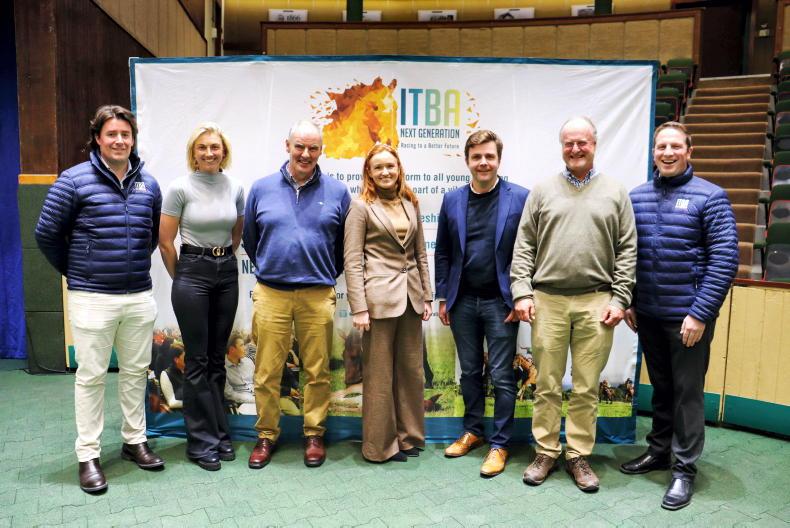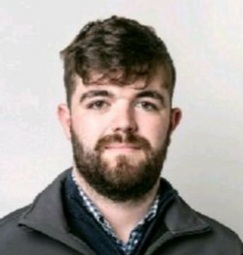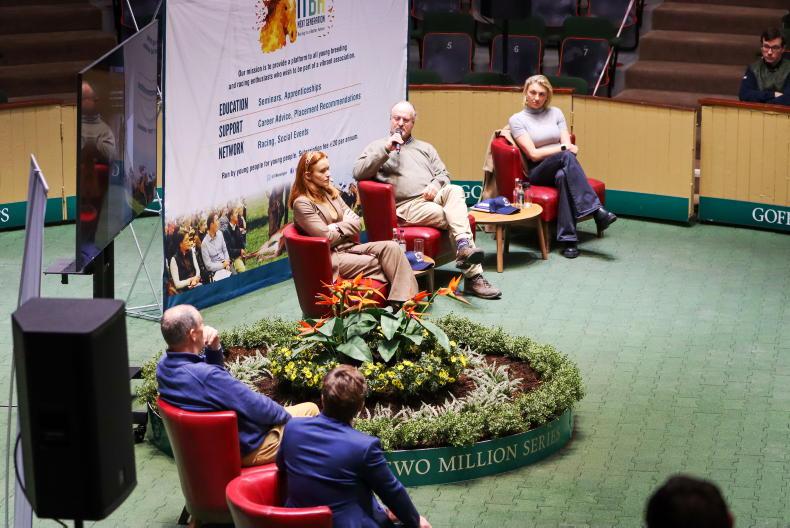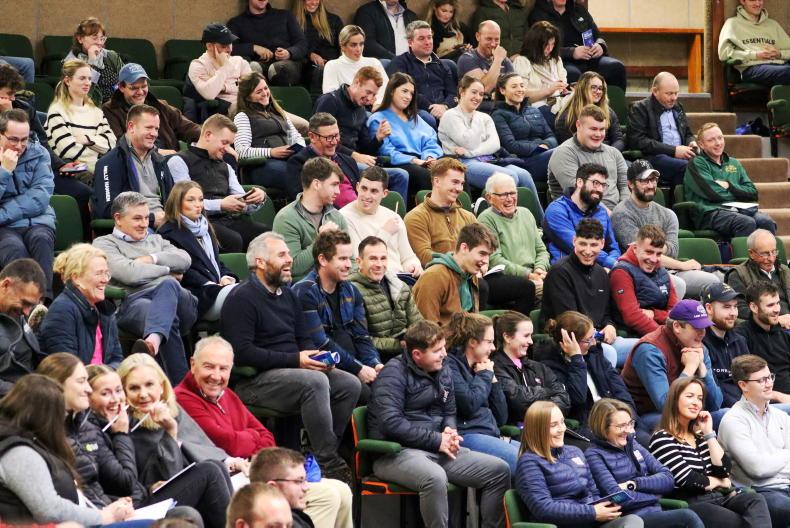With the sales season in full flow, ITBA Next Generation recently held a seminar on pinhooking. A huge crowd filled the Goffs sales ring to hear the thoughts of four experienced industry members. Joining Jane Mangan (MC) on the panel were Alice Kavanagh (AK Thoroughbreds), Paul McCartan, Tom O’Brien (Consultant Equine Surgeon) and Philip Stauffenberg of Stauffenberg Bloodstock.
Following some introductions and a brief conversation about the background of each of the panellists, MC Jane Mangan commenced her questioning with the youngest member of the panel Alice Kavanagh. Mangan enquired with Alice about the benefits of forming a syndicate and how to budget appropiately.
“I suppose most people here tonight are young people. The most common way young people can buy is to form a syndicate and pool your money together to buy something that is going to be more valuable as a yearling rather than buying something for a couple of grand yourself. Budget is a huge thing for people to have at the forefront of their minds. There is no point in wasting time on horses that you are realistically not going to be able to afford. You will only drive yourself mad.”
Kavanagh went on to speak about how something as small as a dam’s name has to be taken into consideration especially when picking out a sale for you to sell on your purchase.
“Generally speaking, for a yearling sale, they move the dam’s name forward four letters every year. A lot of the sales do start on the same letter but some don’t. Many people, including myself, believe that where you land on the sale, whether it be time of the day or the day of the sale, can impact the value.”
Successful German bloodstock agent Philip Stauffenberg was next up in Jane Mangan’s line of questioning. Stauffenberg first spoke about the tricky elements of buying and selling in Ireland when you have a base in another country.
“There is one limiting factor for me compared to most people at the sales. I ship everything home to Germany. And from Germany then to the sales. So, all the costs and logistics are more complicated than most of my competitors. For me from a logistics perspective, I cannot cover every sale. I try to focus on stallions of foals which I can get into one of the select sales.
“For that reason, as well, I usually eliminate the stallions which are just not appealing to higher-end buyers. Unfortunately, I eliminate the fillies who do not have a good enough page. I made the mistake last year of buying a filly who I really liked physically, but she didn’t have a good enough page, so when it came to selling her, nobody wanted to buy her. I probably will look at around 650 out of 1,000 foals because a certain number is eliminated by just paper.”
Philip also went on to speak about the importance of building a brand and making a name for yourself in the industry.
“If you are starting off, if you are not losing money and produce a nice horse then you should set up your brand and build your name. If you only aim at making money, people will start to say, okay it’s expensive to buy off them and the horses usually turn out to be useless. In the end, the most important thing is that we sell racehorses.”
Paul McCarten went on to further develop on Philip’s comment on trying to put more focus on selling good racehorses than making money.
“I agree with Philip. You are in it for the long haul. You want to be selling horses that go on to be good racehorses. But it is a balancing act between the two, you have to make money as well. Generally, I don’t mind selling a horse cheap if it goes on to be a good racehorse. You don’t know where the good horses are going to come from, sometimes it is a horse you bred and sometimes it’s one you buy.”
Paul also gave us an indication of what he looks for when buying a filly.
“I still kind of go for fillies that are half the blacktype rather than have the blacktype themselves. I think they make better broodmares. Then when you are looking for a stallion for the broodmares, you have your own personal favourites. I remember speaking to Rory Mahon one time about Juddmonte. He said when they strike gold with a mating, they repeat it and repeat it and repeat it. If it’s good enough for Juddmonte it is good enough for me. “
Tom O’Brien is a Consultant Equine Surgeon who specialises in working with foals. Tom spoke about the importance of trying to get a foal to toe out at an early stage and the method that can be used to achieve this.
“A lot of work that I do is with foals, sometimes to get them to a foal sale, but more often than not to get them to a yearling sale. Foals will generally be toeing out but as they get older and start to straighten, they can sometimes go too far the other way and toe in substantially. The work that I do is nearly always on getting a foal to toe out. The window of opportunity that you have to get them from being straight or toeing in is very short. Once they are 12 or 16 weeks old there isn’t a suitable surgical intervention.
“In foals, I am not worried about knee action, it is all about the foundation. If a foal is quite straight or toeing in at say seven or eight weeks, I do advise that we look at putting a screw in across the growth plate. It stops the growth plate growing on the outside, the inside stays growing and they begin to toe out.”


 This is a subscriber-only article
This is a subscriber-only article
 It looks like you're browsing in private mode
It looks like you're browsing in private mode







SHARING OPTIONS: